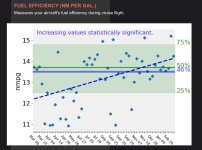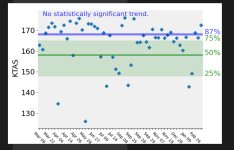Van's Air Force
You are using an out of date browser. It may not display this or other websites correctly.
You should upgrade or use an alternative browser.
You should upgrade or use an alternative browser.
Does anyone have a True Airspeed chart for the RV10 at different altitudes?
- Thread starter okent
- Start date
There are lots of variables of course but I usually plan on 160 KTAS for anything between 9000’ and 13,000’ (density alt) running full throttle, 2300 rpm and LOP at around 10 gal/hr fuel flow. Higher up (up to 17000’) I’ll increase RPMs to maintain the 160 ktas. No data above FL180, I’m on basic med and use cannulas for O2.I may be looking over it somewhere but was wondering if that exists somewhere. Would help for planning to know what performance to expect at different altitudes.
Thanks
aturner
Well Known Member
Echoing Bob, lots of variables, with the big one being "how much fuel do you want to burn?". With that qualifier, here are a couple of graphs that show data downloaded from my G3X after long cross-country flights at different altitudes. So, real world results, bugs on the wings and all. If interested in an excel file with the underlying data, PM me and I will send it along. Sidestory: I teach a statistics course, and each year I ask your question "how high should I fly?", give my students the data, and let them evaluate RV-10 performance. Fun stuff.
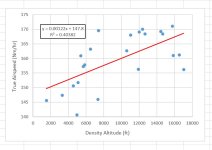
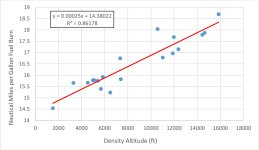


I may be looking over it somewhere but was wondering if that exists somewhere. Would help for planning to know what performance to expect at different altitudes.
Thanks
aturner
Well Known Member
Most of the scatter in the TAS graph, of course, is simply due to variation power settings. Any serious analysis needs to move beyond single variable models. We use a multiple regression approach, but you probably aren’t interested in that.
Wow - the real-world scatter in that data! Graph 1 looks like you were patterning a turkey gun.
View attachment 63350
Thanks for the info. I'm running a SDS EFII system and so far have about 50 hours in the plane. All of my other airplanes have been Rotax engines so I fly slightly rich of peak as of right now. Don't want to screw up anything by trying to run lean of peak. My generic flight planning is for 15 GPH and 165 knots but haven't flown anywhere higher than 8500ft. Just trying to get a baseline for what everyone is seeing on fuel flows and true air speeds at different altitudes.
Roadjunkie1
Well Known Member
There's an ap for that............I may be looking over it somewhere but was wondering if that exists somewhere. Would help for planning to know what performance to expect at different altitudes.
Thanks
Bill Boyd
Well Known Member
You won't screw anything up operating LOP - just level off, pull deliberately past peak and stay out of the "fin" for any length of time, and start enjoying some economy and range. I flight plan for 160 KTAS and 11.3 gph - she'll do better up higher but the wife complains above about 9k and I haven't installed the O2 concentrator yet to help her with her feels...
Andy, it's been a LONG time since Lies, Damned Lies, Probability and Sadistics, but I get where you are coming from. I do NOT want a refresher course - my brain still hurts from 1977.
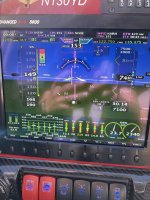
Andy, it's been a LONG time since Lies, Damned Lies, Probability and Sadistics, but I get where you are coming from. I do NOT want a refresher course - my brain still hurts from 1977.

Last edited:
That is WAY more than slightly rich! At 9-10K, I am getting 165 KTAS @ 10.5 - 11 GPH depending upon the day. At 14K, I am getting the same speed but under 9.5 GPH. Granted that is with balanced injectors and optimal ignition advance, but you have that as well with SDS. I can get 175+ true when ROP at 13 GPH.Thanks for the info. I'm running a SDS EFII system and so far have about 50 hours in the plane. All of my other airplanes have been Rotax engines so I fly slightly rich of peak as of right now. Don't want to screw up anything by trying to run lean of peak. My generic flight planning is for 15 GPH and 165 knots but haven't flown anywhere higher than 8500ft. Just trying to get a baseline for what everyone is seeing on fuel flows and true air speeds at different altitudes.
Larry
AeroEngineer
Active Member
The ap might be TruAirspeed.Put in IAS, altitude, OAT, Kollsman (aka barometric pressure in "Hg). Readout: TAS; Mach number...
This was my first reaction too: TAS can be easily calculated if you have CAS (or IAS, close enough), OAT, and altitude... but that's universal to any airplane, not specific to the RV-10. Given that the original post asks about the RV-10, I presumed (as did the other replies) that the question was TAS as a function of power settings.
1001001
Well Known Member
I'd be really interested in that underlying data. My wife is a statistician and I might bother her for some help. PM sent.Echoing Bob, lots of variables, with the big one being "how much fuel do you want to burn?". With that qualifier, here are a couple of graphs that show data downloaded from my G3X after long cross-country flights at different altitudes. So, real world results, bugs on the wings and all. If interested in an excel file with the underlying data, PM me and I will send it along. Sidestory: I teach a statistics course, and each year I ask your question "how high should I fly?", give my students the data, and let them evaluate RV-10 performance. Fun stuff.
View attachment 63345View attachment 63344
For the OP: ‘slightly’ rich of peak egt (50 F?) is probably the worst place to operate your engine in terms of peak pressures and temperatures, and lowest resistance to detonation. OTOH at 15 g/hr I think you must be much richer than ‘slightly’ rich.
Read and learn about lean of peak (LOP) operation. I’m a convert. I find I have a fair number of trips (700 - 800 nm, no wind) where I can go non-stop at 160 ktas (LOP) but have to make a fuel stop if running 172 ktas (best power mixture), e.g. get to the destination faster by flying slower! Standard 60 gal tanks. In fact, I think those 60 gal tanks are too small for a lot of ifr flights where you need gas to destination, then alternate, plus reserves, if you fly at best power. But they work fine at 10 gal/hr.
The -10 loves higher altitudes. I think having O2 is almost mandatory here in the west. Choose the altitude based on ground speed (e.g., maximize tailwind or minimize headwind). I’ve seen over 200 knots ground speed a fair number of times west bound at 15000-17000’ (I’m limited to 18K by basic med or I’d try the flight levels on some days.) At the very least, take your plane up to 11500’ or 12500’. You’ll love the generally smooth, cool air, low traffic.
Read and learn about lean of peak (LOP) operation. I’m a convert. I find I have a fair number of trips (700 - 800 nm, no wind) where I can go non-stop at 160 ktas (LOP) but have to make a fuel stop if running 172 ktas (best power mixture), e.g. get to the destination faster by flying slower! Standard 60 gal tanks. In fact, I think those 60 gal tanks are too small for a lot of ifr flights where you need gas to destination, then alternate, plus reserves, if you fly at best power. But they work fine at 10 gal/hr.
The -10 loves higher altitudes. I think having O2 is almost mandatory here in the west. Choose the altitude based on ground speed (e.g., maximize tailwind or minimize headwind). I’ve seen over 200 knots ground speed a fair number of times west bound at 15000-17000’ (I’m limited to 18K by basic med or I’d try the flight levels on some days.) At the very least, take your plane up to 11500’ or 12500’. You’ll love the generally smooth, cool air, low traffic.
Richard Connell
Well Known Member
Paddy
Well Known Member
I find that TAS doesn't vary that much running LOP at cruising altitudes between 6 and 12K. I get a fairly consistent 168 - 170KTAS @10.5 - 11GPH. This is with dual Surefly ignitions with advance enabled. What does make a significant difference in my plane is CG. There's a good 5 - 6 kts difference between forward and rearward loading within the envelope. That said, I took this picture a few months back because of the 236kt ground speed. I kept the prop at 2,350 but bumped up the mixture just to see what she'd do. Close to perfect scenario, solo with baggage in the back and light fuel, cold outside and smooth air...




